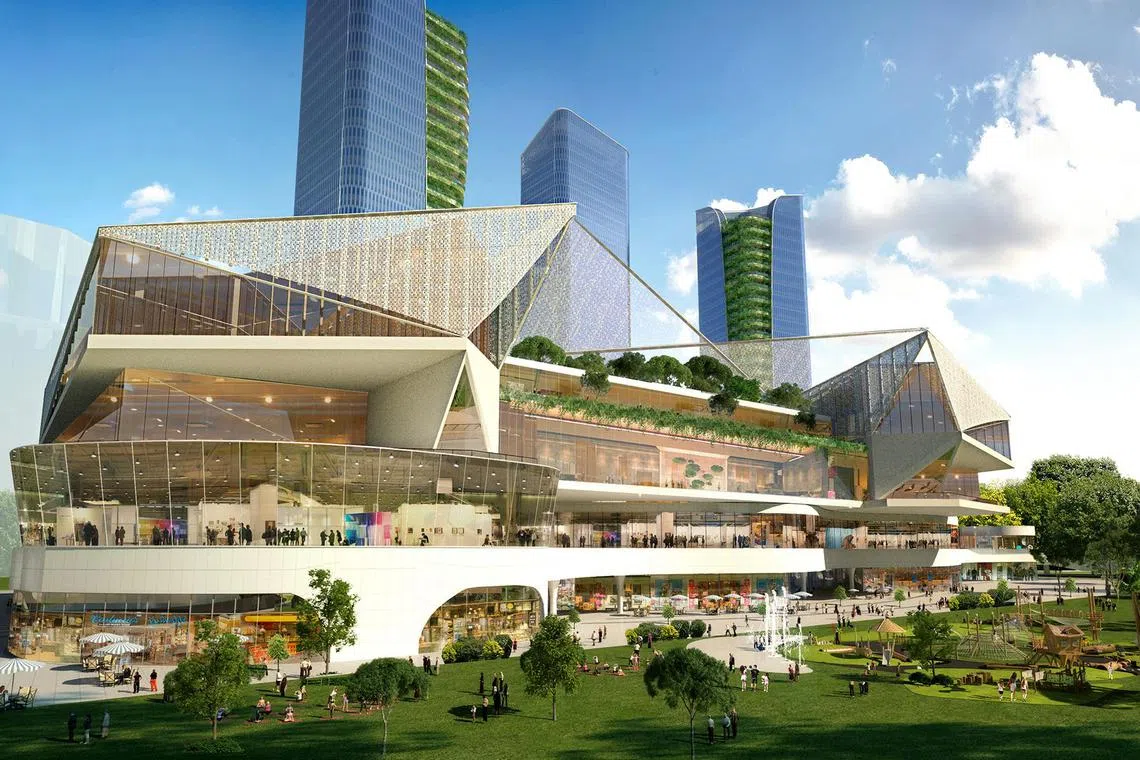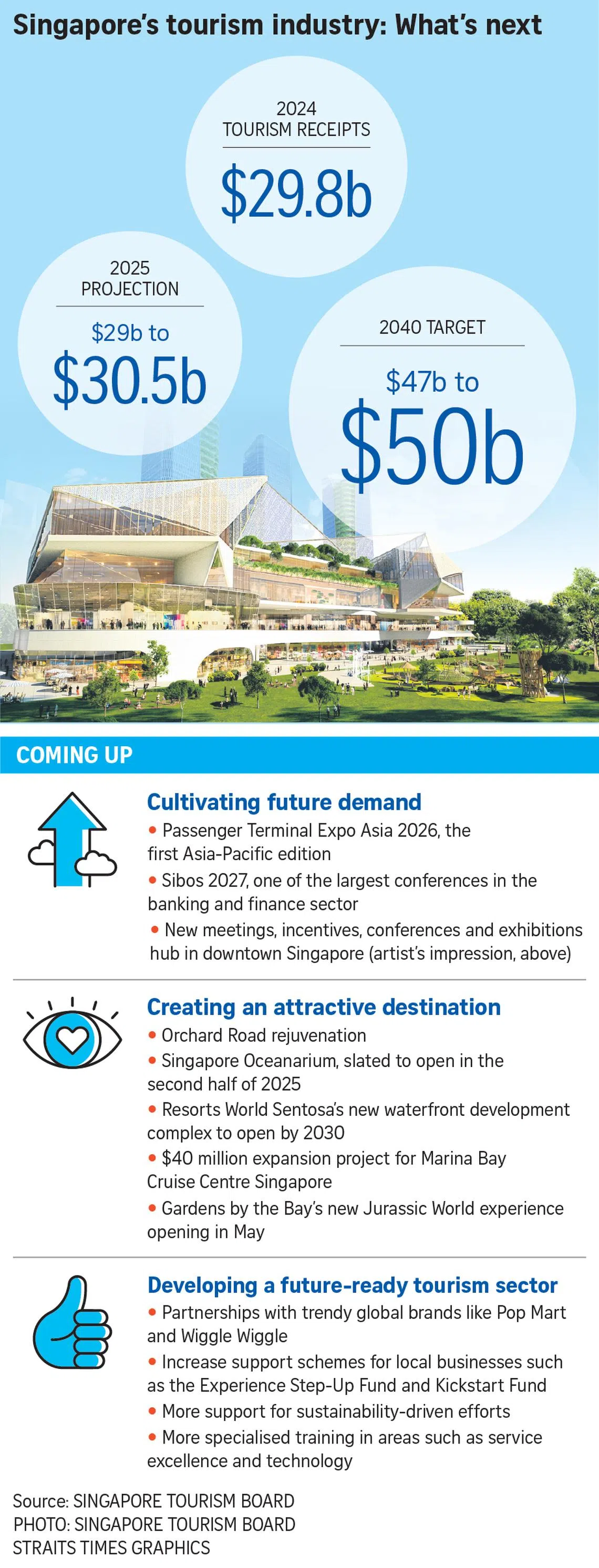Singapore targets $50 billion in tourism receipts by 2040; eyes Mice sector as key growth driver
Sign up now: Get ST's newsletters delivered to your inbox

The Singapore Tourism Board expects the rate of tourism spending to outpace the growth in visitor arrivals.
ST PHOTO: AZMI ATHNI
Follow topic:
SINGAPORE – Tourism spending in Singapore is projected to reach between $47 billion and $50 billion by 2040 – around 1.7 times 2024’s figure, Minister-in-charge of Trade Relations Grace Fu said on April 11.
In 2024, the country recorded an all-time high of $29.8 billion in tourism receipts, driven largely by visitors from top spending markets such as China, Indonesia and Australia.
International visitor arrivals hit 16.5 million, underscoring a strong post-pandemic rebound.
Looking ahead, the rate of tourism spending is expected to outpace the growth in visitor arrivals, as Singapore shifts its focus from volume to value, said Singapore Tourism Board (STB) chief executive Melissa Ow.
This vision is encapsulated in the STB’s Tourism 2040 road map, which revolves around three key pillars: cultivating future demand, enhancing Singapore’s appeal as a destination, and developing a future-ready tourism sector.
One of the key growth engines lies in the Mice (meetings, incentives, conferences and exhibitions) segment, which Ms Fu identified as a “high-growth and quality visitor segment”.
Ms Fu and Ms Ow were speaking at the Tourism Industry Conference on April 11.
The annual event, which was held at Suntec Singapore Convention and Exhibition Centre, is for STB and the tourism and travel trade industry to take stock of tourism trends and market insights.
STB aims to triple Mice tourism receipts by 2040. According to a 2019 study by STB, Mice travellers contributed around $1.4 billion – or around 4 per cent – to Singapore’s tourism receipts. Ms Ow estimates that this will increase to 10 per cent by 2040.
Mice travellers tend to spend twice as much as leisure travellers, said Ms Fu, and with the global Mice sector projected to double in value over the next decade, the Asia-Pacific is emerging as one of its fastest-growing markets.
STB is also studying the development of a Mice Hub in Singapore’s downtown district. The new facility is expected to complement and bolster the Mice offerings in the area, and will leverage existing Mice venues and attractions in the city with the aim of enriching the visitor experience.

Singapore Tourism Board is studying the development of a Mice Hub in the downtown area, which is planned to complement and bolster the existing Mice facilities in the area.
PHOTO: SINGAPORE TOURISM BOARD
In parallel, efforts to rejuvenate key tourism precincts such as Orchard Road and Sentosa are under way, with a focus on offering more diverse and immersive experiences.
For instance, Minion Land opened at Universal Studios Singapore on Feb 14,
To amplify Singapore’s global appeal, STB has also launched partnerships with trendy brands such as toy collectibles giant Pop Mart and South Korean lifestyle label Wiggle Wiggle, with the aim of bringing fresh, pop culture-driven experiences to the city.
Despite the optimism, Ms Ow remained cautious amid ongoing trade tensions.
She said: “This year, the global economic outlook appears more uncertain. For now, it is too early for us to determine the impact on travel and tourism, and we will monitor these developments very closely.”
Ms Fu added: “Following the imposition of the United States tariffs, we expect a more challenging global environment. As countries revise their growth rates downwards, we expect consumer confidence to be adversely affected.
“Even as we look ahead to a pipeline of events that will invigorate our tourism landscape, we must brace ourselves for near- to medium-term volatility that will test our adaptability.”
STB projects tourism receipts to reach between $29 billion and $30.5 billion and international visitor arrivals to hit 17 million to 18.5 million in 2025.
Dr Ye Guangzhi, assistant professor of economics at NTU, believes the ongoing trade tensions could impact tourism.
“When economic growth slows, overall demand for tourism tends to decline. This is because tourism spending is generally considered ‘elastic’. It is more likely to be reduced or postponed compared with more ‘inelastic’ types of spending, such as on everyday necessities,” he said.

A slowdown in economic growth could spell trouble for tourism.
ST PHOTO: TARYN NG
“As a result, the tourism industry is particularly vulnerable to downturns in economic confidence and shifts in currency values, both of which can significantly influence travel decisions and destination preferences.”
For the year ahead, STB has a slew of new tourism products and experiences, partnerships as well as refurbishments planned.
New cruise offerings include Disney Cruise Line’s first Asia cruise – the Disney Adventure – and the introduction of Ritz-Carlton Yacht Collection’s Luminara for the luxury segment.

New cruise offerings include Disney Cruise Line’s first Asia cruise – the Disney Adventure.
PHOTO: DISNEY CRUISE LINE
Marina Bay Cruise Centre Singapore will also see a $40 million investment
For Mice events, Singapore will host medtech conference LSI Asia 2025 – the first edition in Asia – and Herbalife Extravaganza 2026, which is expected to get 25,000 visitors.
Mr Michael Wilton, chief executive and managing director of exhibition organiser MMI Asia, said business travellers have become more value-minded – looking beyond the event to the host destination and its offerings as reasons to travel for work.
“They might have a fantastic time at the show, but if their travel was horrible and their hotel was horrible, then it is very difficult to make them come back again. That’s where Singapore’s advantages, in terms of its Mice infrastructure and accessibility, make it attractive for event organisers,” he said.
Mr Leck Chet Lam, managing director of Experia Events, agrees, but said rising costs in Singapore need to be closely monitored.
He added: “It’s factual that we are more expensive (than some of our regional competitors) but we need to view it from a balance between price and efficiency, and make sure we always provide value to the corporate traveller as a destination.”
Mr Leck suggested that Mice events of the future leverage emerging trends and technologies like artificial intelligence to improve the user experience.

Destination hotels – where hotels are the destination in and of itself due to unique factors such as experiences, attractions and architecture – have been identified as a trend.
An example is the Mandai Rainforest Resort by Banyan Tree,
Visitors can also look forward to more sports and music events, and lifestyle offerings with an increased focus on wellness.
Mr Wee Teng Wen, managing partner at hospitality company The Lo and Behold Group, said while attractions and events entice tourists to come to Singapore, lifestyle offerings “give them a reason to stay”.
“More and more, tourists are looking for local brands and craving experiences that are unique to the city. I’ve always believed the best way to experience a city is through its hospitality,” said Mr Wee, who leads the team behind lifestyle development New Bahru.
Ms Ow said that in 2024, tourism companies committed more than $3.2 billion in investments that went into new products and experiences, but added that “there is much to be done”.
“Work has already started, and we are putting in place the building blocks that will anchor our future as a world-class destination, as a global hub and a home that we proudly advocate for,” she said.
Correction note: In an earlier version of this story, we said that the Singapore Oceanarium is set to open in the first half of 2025. This is incorrect. It should be in the second half of 2025.


